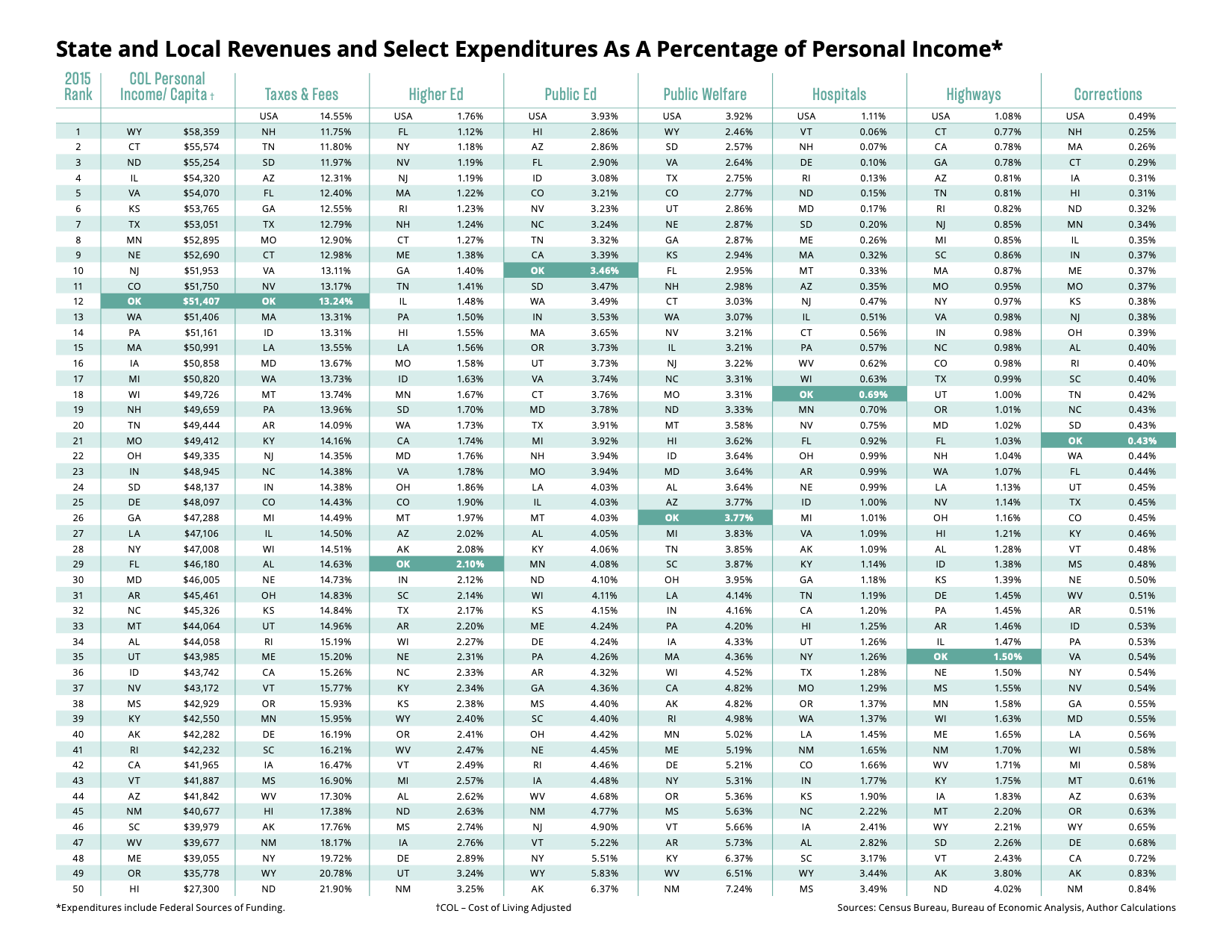Comparing Oklahoma Government Revenues and Spending

Authors
Byron Sclomach, Vance H. Fried
Abstract
This paper compares state and local taxes and spending in six areas as a percentage of personal income across states. It finds that if Oklahoma were 10 percent more efficient with state and local funds, doable given comparisons with other states, it could redirect or save taxpayers $2 billion.
Full Text HTML
Comparing Oklahoma Government Revenues and Spending
Byron Schlomach and Vance H. Fried
Oklahoma’s state and local governments: (See Reverse)
- Collect 13.2 percent of Oklahomans’ personal income in taxes and fees, more than 11 other states, including Texas and Missouri.
- Spend a higher percentage of our income on higher education than 28 states.
- Spend a higher percentage on public education than 8 states, including Arizona, which leads the nation in academic gains measured by the National Assessment of Educational Progress.
- Spend a higher percentage of state personal income on public welfare than 25 states.
- On the six featured spending areas (which include federal dollars), Oklahoma spends 11.95 percent of personal income, only a little below the national average of 12.29 percent.
Unfortunately, Oklahoma is not a leading state when it comes to minimizing the size of government. Oklahoma trails both Texas and Missouri, as well as 9 other states, including New Hampshire, Tennessee, Arizona, and Florida..
Hypothetically, if a single state’s spending on the six featured areas in the table (see reverse) were at the levels of the states ranked at the bottom in each category, that state would have spent over 25 percent of residents’ total personal income. If a hypothetical state spent at the levels of the top of the rankings in each of the six categories, it would spend only 7.5 percent of residents’ total personal income.
Suppose that instead of its current levels of spending in the six featured categories, Oklahoma were more efficient and effective with its money and spent at levels of states ranked above it. Georgia spends 1.4 percent of personal income on higher education but has a system that promises many a free college education. Florida’s public education system spends only 2.9 percent of income in that area. Texas, similar in many ways to Oklahoma, spends only 2.75 percent of income on welfare and less than 1 percent on highways. Missouri spends .37 percent on corrections. Massachusetts spends only .32 percent of its income on hospitals. There is no reason to think that the quality of services in these states is inferior to what Oklahoma provides.
Combining the above percentages, if Oklahoma were to improve to those levels, its spending in the six categories would amount to 8.73 percent of personal income. That would represent a 26 percent cost reduction in those areas. If Oklahoma’s state and local governments improved their operations efficiency so that purely state and local-financed spending dropped by just 10 percent, over $2 billion could be redirected to enhance existing government services, provide new services, or be returned to taxpayers.
States spend different levels of taxpayers’ income in different areas for a variety of reasons. One reason might have to do with affordability in the state and levels of income. However, in the far left column, states’ personal income adjusted for cost of living is provided. Oklahoma is 12th, but our levels of spending across the six categories is all over the place. For the most part, states’ personal income rankings are not well correlated to either spending or overall tax levels.
